Aspects of Nakaoki
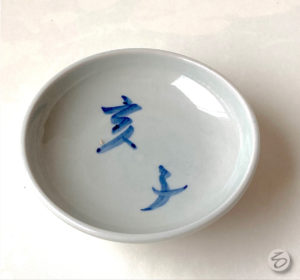
The two Kanji together are read i-no-ko, 亥の子, Boar-’s-child, or i-ne, 亥子, boar-rat, which is a homonym for ine, 稲, rice plant. Opening the sunken hearth, ro-biraki, 炉開, hearth-opening, is officially presented on the first I-no-hi, 亥の日, Boar-’s-day, in the 10th month, which is followed by Ne-no-hi, 子の日, Rat-’s-day. The reason is that starting something on the last day of the zodiac cycle continues unbroken to the start of the next cycle, hence Boar continues to the Rat.
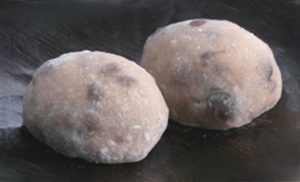
There is an infinite variety of ways in which inoko mochi appear. The pictured sweets are perhaps close to the original look. There are whole beans on the surface of the an, 餡, bean jam, that are seen through the ‘mochi’ covering. It thought that the spots resemble the mottled fur of little boars, I no ko. These much loved sweets are served at ro-biraki, 炉開, hearth-opening, which occurs on October 25, 2022.
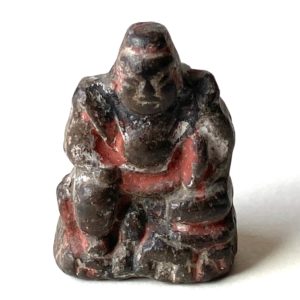
The god of fertility and especially of fisherman, holds a tai, 鯛, sea bream, red snapper, fish under his left arm, and a fishing pole in his right. He is often depicted sitting on a rock in a pose of ‘royal ease’.
E-bi-su-ko, 恵比須講, Bless-compare-necessary-association, held on the 10th day of the 10th month, both solar and lunar calendars. Ebisu, the first-born child of the primal couple I-za-na-mi, 伊耶那美, That-wicked-what-beauty, and I-za-na-gi, 伊邪那岐, That-wicked-what-branch. Even by the age of three he could not walk and was put into a boat made of kusu, 楠, camphor wood, and set adrift on the Ama-no-kawa, 天の川, Heaven-’s-river, the Milky Way. Ebisu eventually became an important Shintō deity, and is the only native Japanese god of the Shichi-fuku-jin, 七福神, Seven Fortune-gods. One of his childhood names was hiro-ko, 蛭子, leech-child, as he could not walk. His name, Ebisu, is written in many different ways, and with alternate Kanji; the same is true with the names of his parents.
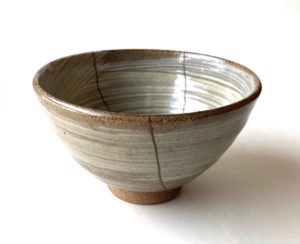
The pictured chawan was one of many used to serve Tea over an extended period to the hundreds of visitors to the Japan House Gallery in New York City. The Tea presentations were part of an extraordinary nationwide event called ‘Japan Today’ that was held in 1979. Only two of the bowls got broken, and this one was saved by Michael Kane, one of the several presenters, such as myself. Michael had an aversion to broken and repaired utensils, however he rescued this bowl and had it repaired. Before his death, he willed the bowl to me.
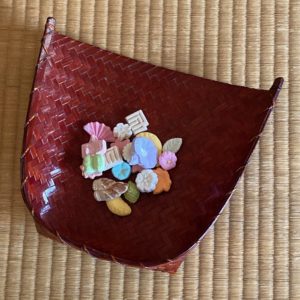
Sweets that have remained toward the end of the furo season are served in a mi, 箕, winnow basket. These various hi-ga-shi, 干菓子, dry-sweet-of, gathered together can be called fuki-yose, 吹き寄せ, blown-together, like autumn leaves. Sweet shops make a variety of sweets in the form of autumn leaves, pine cones, etc. for those who want some new sweets.
Mi, 箕, winnow; bamboo basket with shun-kei nuri, 春慶塗, The collecting basket is identified with various agriculture deities, and is very close to Ebisu. The shōmen of the mi is a bit of a mystery as to what is the front. Rikyū’s rule of shōmen is maru mae kaku muko, 丸前角向, round fore corner opposite. With regard to the mi when serving higashi, the round part is shōmen, as if it had a handle. It is as though one where sweeping leaves into a ‘dust pan’ with the straight edge of the winnow flat on the ground.
A prime use for the mi is to separate the rice from the chaff, by holding the round part and tossing the rice in the air to let the wind blow away the chaff. Ebisu is also a god of rice growing.
Mi-boshi, 箕宿, Winnow-mansion, is one of the Ni-jū-hachi-shuku, 二十八宿, Two-ten-eight-mansions, the twenty-eight Asian constellations. Miboshi is one of the seven constellations in the sign of the Sei-ryū, 青龍, Azur-dragon in the east quadrant, and is part of Sagittarius.
Nokori-cha, 残り茶, remaining-tea, the last of the year’s tea is served toward the end of October. The year’s new tea picked around hachi-jū-hachi ya, 八十八夜, eight-ten-eight night, is first served at ro-biraki, 炉開, hearth-opening.
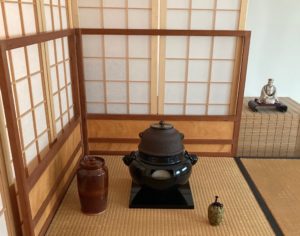
Utensils placed for the Tea presentation of Naka-oki, 中置, Middle-place, with fu-ro, 風炉, wind-hearth, in the exact center of the ten-mae, 点前, offer-fore, half-tatami. The mizu-sashi, 水指, water-indicate, is placed to the left of the furo, and the cha-ire, 茶入, tea-receptacle, is placed to the right. The mizusashi is placed half-way between the heri binding and the left edge of the furo shiki-ita. This differs according to the size of the board. The chaire is placed in its usual location, 7 sun kane-jaku to the right of the middle of the tatami.
It is thought by many people that the furo is moved closer to the guests because the weather turns colder toward the end of the autumn. This may be true to a certain degree, however, if the room does not have a ro, 炉, hearth, the furo is not kept in the middle of the tatami, but is moved back to the left side of the tatami in its usual location.
